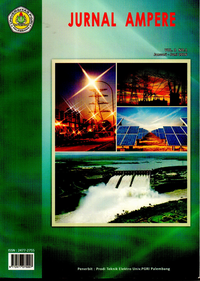STUDI KELAYAKAN PLTSa TPA SUKAWINATAN SEBAGAI SUMBER ENERGI ALTERNATIF DI KOTA PALEMBANG
DOI:
https://doi.org/10.31851/ampere.v2i2.1772Keywords:
Landfill gas, gas flow, Methane, Well LFGAbstract
Â
Â
ABSTRAK
Â
         Usaha pemanfaatan atau recovery LFG menjadi sumber energi merupakan salah satu cara yang dapat dilakukan untuk meminimalisir dampak negatif terhadap lingkungan. Beberapa negara industri bahkan telah mengkomersilkan gas yang terbentuk dari sebuah landfill sampah kota. Energi yang diperoleh dari penangkapan dan pembakaran gas metana landfill dapat digunakan untuk menghasilkan listrik. Sampah domestik pada TPA Sukawinatan yang diolah dengan sistem sanitary Landfill (lahan urug saniter) akan menghasilkan biogas yang berupa gas metana (CH4) yang dapat dipergunakan sebagai sumber energi pada gas engine untuk menghasilkan listrik. Dengan volume sampah yang masuk ke TPA Sukawinatan sebesar 400-500 ton perhari, prediksi rata-rata gas flow sebesar 150-270 Nm3/h dengan sumber pada TPA Sukawinatan zona C,D dan K dapat memberikan gas flow sebesar 450-510 Nm3/h, sedangkan yang dibutuhkan untuk membangkitkan listrik 500 KW pada Pembangkit Listrik Tenaga Sampah di TPS Sukawinatan hanya sebesar 270-300 Nm3/h pada 50% konsentrasi metana pada well LFG.
Kata kunci : Landfill gas, gas flow, Metana, Well LFG
LFG utilization or recovery effort into an energy source is a way that can be done to minimize negative impact on the environment. Some industrialized countries have even commercialized gas formed from a municipal waste landfill. The energy obtained from capture and combustion of landfill methane gas can be used to generate electricity. Domestic waste in Sukawinatan TPA treated with sanitary landfill system will produce biogas in the form of methane gas (CH4) which can be used as energy source in gas engine to generate electricity. With the volume of garbage entering the Sukawinatan TPA of 400-500 tons per day, the average gas flow forecast of 150-270 Nm3 / h with the source at TPA Sukawinatan zones C, D and K can provide gas flow of 450-510 Nm3 / h , while those needed to generate 500 KW of electricity at the Waste Power Generation at Sukawinatan TPS are only 270-300 Nm3 / h at 50% methane concentration in well LFG.
Â
Keywords: Landfill gas, gas flow, Methane, Well LFG
References
Didik Eko,Gunawan, 2011, Studi Perencanaan Pembangkit Listrik Tenaga Sampah dengan Teknologi Dry Anaerobic Convertion, Prosiding Seminar Nasional Sains dan Teknologi ke-2 Tahun2011, Fakultas Teknik Universitas Wahid Hasyim Semarang, Jawa Tengah, Indonesia.
Modul TPA Sukawinatan, Palembang, Indonesia, 2016,
Published
How to Cite
Issue
Section
License

Jurnal Ampere is licensed under a Creative Commons Attribution-ShareAlike 4.0 International License.
Authors who publish with this journal agree to the following terms:
- Authors retain copyright and grant the journal right of first publication with the work simultaneously licensed under a Creative Commons Attribution License that allows others to share the work with an acknowledgement of the work's authorship and initial publication in this journal.
- Authors are able to enter into separate, additional contractual arrangements for the non-exclusive distribution of the journal's published version of the work (e.g., post it to an institutional repository or publish it in a book), with an acknowledgement of its initial publication in this journal.
- Authors are permitted and encouraged to post their work online (e.g., in institutional repositories or on their website) prior to and during the submission process, as it can lead to productive exchanges, as well as earlier and greater citation of published work.






